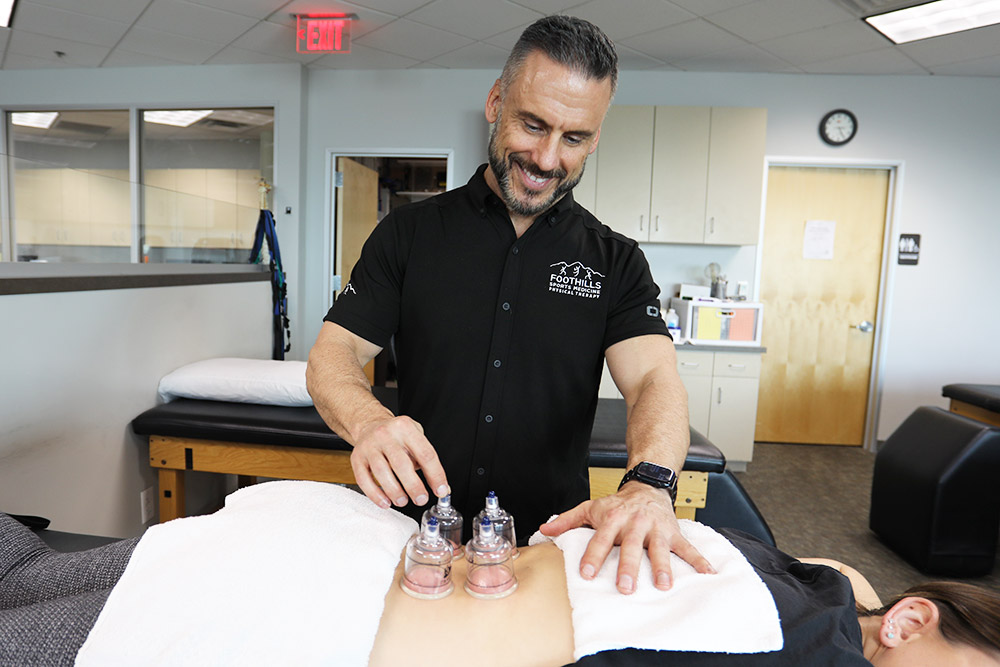By Aspen Cooper, PT, DPT | Old Town Scottsdale location
Cupping therapy is a form of traditional Middle Eastern and Chinese medicine dating back to 280 A.D. This ancient alternative medicine treatment increases blood flow, which can help alleviate symptoms from a broad range of conditions, including chronic pain.
What is Cupping?
Cupping therapy is a type of bloodletting that involves placing warm to hot cups on your skin, creating a partial vacuum. This causes suction that pulls blood to the skin level, stimulating healing.
Various healthcare professionals receive training in cupping therapy, including:
- Physical therapists
- Chiropractors
- Acupuncturists
- Massage therapists
- Medical doctors
Modern cupping uses cups that are rounded on one end, open on the other, and often made of glass. However, depending on the practitioner, they may also be ceramic, bamboo, silicone, plastic, or earthenware.
4 Key Benefits of Cupping Therapy
Cupping relies primarily on cup suction to stimulate the healing process. Additionally, it doesn’t require drugs to be effective and can be combined with other treatments, such as dry needling or acupuncture, to increase the duration of relief.
Cupping therapy has several benefits that can help in the treatment of a broad range of complaints, including the following:
1. Reduces Inflammation
Patients often agree to this treatment to help alleviate inflammation. The suction from the cups causes micro-trauma. Your body releases white blood cells, chemicals, and fibroblasts to the area, triggering the healing process.
2. Offers Pain Relief
Patients with rheumatic diseases such as lumbago, arthritis, rheumatism, and joint pain often use cupping therapy to heal the body organically. Because it increases blood flow, cupping therapy can help deliver vitamins, oxygen, hormones, and nutrients to the areas of the body that need it the most. It also helps boost the flow of synovial fluid to the joints, helping enhance elasticity and reduce pain.
3. Improves Circulation
The suction from the cups draws blood through the veins, drawing it closer to the surface and enhancing blood flow. This process strengthens the veins and arterial muscles while eliminating blood congestion.
Consistent blood flow enables the body’s systems to function well, improving neurological processes and your ability to move. The immune system is bolstered when the body is strong, providing defense against various illnesses.
4. Decreases Chronic Fatigue
Stress can take a toll on you emotionally and physically. If toxins resulting from the stress overload your system, pain and soreness may begin or increase. Cupping therapy can help you relax, reducing stress levels and chronic fatigue. People who struggle with sleep problems and unexplained fatigue symptoms often find relief from cupping.
Cupping is commonly used to stimulate healing for conditions including:
- Migraines
- Arthritis
- Back and neck pain
- Carpal tunnel syndrome
- Improving immune system functions
Depending on the session’s goals, the practitioner typically places one to several cups on your skin. However, different cupping methods exist, and your condition may determine the best approach.

Types of Cupping
1. Static (also known as dry cupping)
The therapist places a cup on your skin and uses a pump to create suction. This method draws fluid and blood away from inflamed areas, bringing them to the surface. The cup tension can range from strong to light or medium.
2. Moving
The practitioner applies oil to the treatment area and places a cup with light tension on the skin. Unlike the other techniques in which the cup remains in place, the therapist moves the cup in circular or sliding movements, massaging the skin.
3. Dynamic
The suction is created by depressing and then releasing a medical-grade silicone cup. Then it is pulled over the skin with the use of massage oil.
Dynamic cupping treats all the same issues as static and moving cupping and has been said to be even more beneficial for lasting myofascial release than its traditional counterpart.

Potential Side Effects of Cupping Therapy
Cupping should only be performed by trained practitioners on healthy skin. When done correctly, the side effects are typically minimal. You may feel lightheaded or dizzy during the treatment. Some patients also experience nausea or sweating during or immediately after a session.
Does Cupping Therapy Leave Bruises?
Because cupping brings blood to the skin’s surface, it may cause temporary marks similar to bruises. The marks left behind also indicate the condition of the treatment area.
If there are no marks or they are light pink, it could mean a lack of blood flow to the area. Darker areas may represent an accumulation of toxins that the cups are helping flush out of your system.
Cupping physical therapy can help your body heal and become stronger. Contact us to schedule a consultation and find out if cupping is recommended to address your aches and pains.





